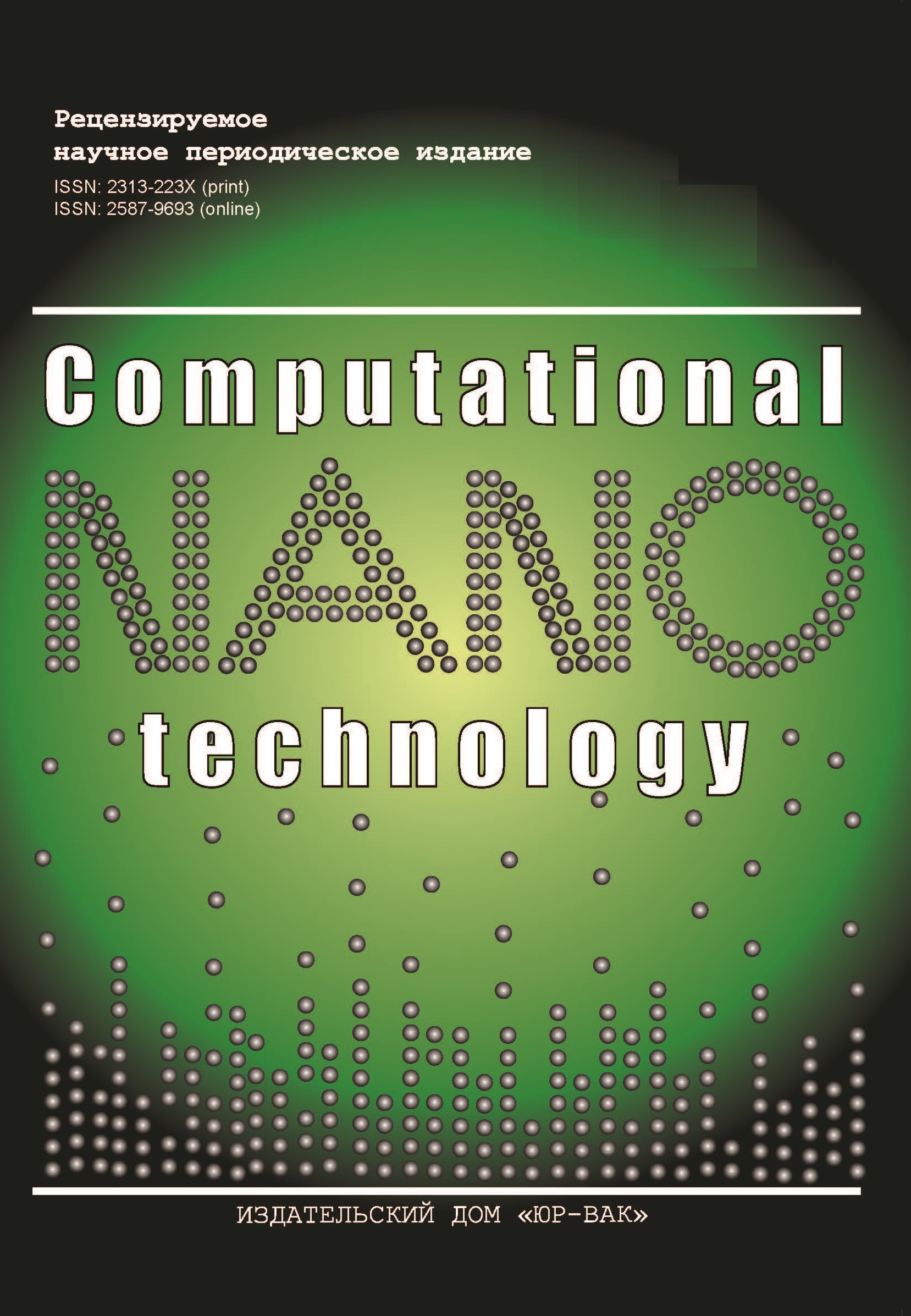Исследование адгезионных свойств слоев Ti, TiN и (Ti, Cr, Al)N, последовательно осаждаемых на поверхность твердого сплава WC92–Co8
- Авторы: Мокрицкий Б.Я.1, Заводинский В.Г.2, Горкуша О.А.2
-
Учреждения:
- Комсомольский-на-Амуре государственный университет
- Хабаровское отделение Института прикладной математики Дальневосточного отделения Российской академии наук
- Выпуск: Том 10, № 2 (2023)
- Страницы: 53-59
- Раздел: НАНОТЕХНОЛОГИИ И НАНОМАТЕРИАЛЫ
- URL: https://journals.eco-vector.com/2313-223X/article/view/568077
- DOI: https://doi.org/10.33693/2313-223X-2023-10-2-53-59
- EDN: https://elibrary.ru/BOLLQP
- ID: 568077
Цитировать
Полный текст
Аннотация
С помощью компьютерного моделирования методами теории функционала плотности и псевдопотенциалов исследована энергетика трехслойного покрытия на поверхности твердого сплава на основе карбида вольфрама WC92–Co8. (техническое наименование ВК8). Первый слой – титан; второй слой – нитрид титана; третий слой – композитный нитрид (Ti, Cr, Al)N. Изучена зависимость энергии адгезии титана к поверхностям WC и Co в зависимости от толщины нанесенного слоя титана (от одного до трех атомных слоев). Вычислена энергия адгезии нитрида титана к предварительно нанесенному слою титана. Для четырех вариантов структуры соединения (Ti, Cr, Al)N вычислена энергия адгезии этого соединения к поверхности TiN.
Полный текст
Об авторах
Борис Яковлевич Мокрицкий
Комсомольский-на-Амуре государственный университет
Автор, ответственный за переписку.
Email: boris@knastu.ru
ORCID iD: 0000-0003-4727-9873
доктор технических наук, доцент; главный научный сотрудник Комсомольского-на-Амуре государственного университета
Россия, Комсомольск-на-АмуреВиктор Григорьевич Заводинский
Хабаровское отделение Института прикладной математики Дальневосточного отделения Российской академии наук
Email: vzavod@mail.ru
ORCID iD: 0000-0003-0958-6282
доктор физико-математических наук, профессор; ведущий научный сотрудник Хабаровского отделения Института прикладной математики Дальневосточного отделения Российской академии наук
Россия, ХабаровскОльга Александровна Горкуша
Хабаровское отделение Института прикладной математики Дальневосточного отделения Российской академии наук
Email: o_garok@rambler.ru
ORCID iD: 0000-0002-8431-5004
кандидат физико-математических наук; старший научный сотрудник Хабаровского отделения Института прикладной математики Дальневосточного отделения Российской академии наук
Россия, ХабаровскСписок литературы
- Григорьев С.Н., Табаков В.П., Волосова М.А. Технологические методы повышения износостойкости контактных площадок режущего инструмента: монография. Старый Оскол: ТНТ, 2011. 380 с.
- Нарыжный А.Г., Куценко Ю.М., Гром М.В., Степаненко Д.Р. Термомеханическая модель процесса резания резцом с износостойким покрытием // Авиационно-космическая техника и технологии. 2014. № 35 (112). С. 4–10. ISSN: 1727-7337
- Верещака А.А., Верещака А.С., Седых М.И. Режущие инструменты с модифицирующими износостойкими комплексами. М.: ФГБОУ ВО МГТУ «Станкин», 2014. 195 с. ISBN: 978-5-7028-0712-6
- Мокрицкий Б.Я., Бурков А.А. Концепция разработки арсенала наукоемких технологических процессов изготовления металлорежущего инструмента // Наукоемкие технологии в машиностроении. 2011. № 4. С. 20–26.
- Зимон А.Д. Адгезия пленок и покрытий. М., Химия, 1977. 352 с.
- Тополянский П.А. Исследование адгезионных свойств и механизма образования покрытия, наносимого методом финишного плазменного упрочнения. Ч. 2 // Матер. 7-й междунар. практ. конф.-выставки «Технологии ремонта, восстановления и упрочнения деталей машин, механизмов, оборудования, инструмента и технологической оснастки», 12–15 апр. 2005 г., Санкт-Петербург. СПб.: Изд-во СПбГПУ, 2005. С. 316–333.
- Hohenberg H., Kohn W. Homogentous electron gas // Phys. Rev. 1964. No. 136. Pp. B864–871.
- Kohn W., Sham J.L. Self-consistent equations including exchange and correlation effects // Phys. Rev. 1965. No. 140. Pp. A1133–A1138.
- Perdew J.P., Wang Y. Accurate and simple density functional for the electronic exchange energy // Phys. Rev. B. 1986. No. 33. Pp. 8800–8802.
- Cohen M.L., Heine V. In: Solid state physics. H. Ehrenreich, F. Seitz, D. Turnbull (eds.). New York: Academic Pres, 1970. Pp. 24, 38–249.
- Beckstedte M., Kley A., Neugebauer J., Scheffler M. Density functional theory calculations for poly-atomic systems: Electronic structure, static and elastic properties and ab initio molecular dynamic // Comput. Phys. Commun. 1997. No. 107. Pp. 187–205.
- Fuchs M., Scheffler M. Ab initio pseudopotentials for electronic structure calculations of poly-atomic systems using density functional theory // Comput. Phys. Commun. 1999. No. 119. Pp. 67–165.
- Yamamoto K., Sato T., Takahara K., Hanaguri K. Properties of (Ti, Cr, Al)N coatings with high Al content deposited by new plasma enhanced arc-cathode // Surface and Coatings Technology. 2003. No. 174–175. Pp. 620–626.
- Bing Yang, Li Chen, Ke K. Chang et al. Thermal and thermo-mechanical properties of Ti–Al–N and Cr–Al–N coatings // Int. Journal of Refractory Metals and Hard Materials. 2012. No. 35. Pp. 235–240.
- Grigoriev S., Vereschaka A., Milovich F. et al. Investigation of the properties of Ti–TiN–(Ti, Cr, Mo, Al)N multilayered composite coating with wear-resistant layer of nanolayer structure // Coatings. 2020. No. 10. P. 1236. doi: 10.3390/coatings10121236
- Blinkov I.V., Tsareva S.G., Zentseva A.V. et al. Structure and phase formation of nanostructural ion-plasma Ti–Cr–Al–N coatings on a hard-alloy cutting tool // Russian Journal of Non-Ferrous Metals. 2010. Vol. 51. No. 6. Pp. 483–489.
Дополнительные файлы











